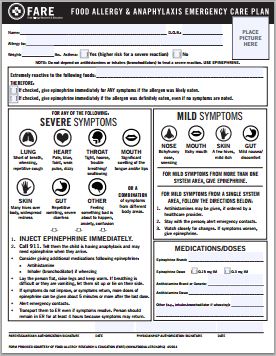Food Allergies-Be Prepared…Be Safe
An effective food allergy treatment plan includes all of the following: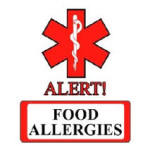
- Strict avoidance of problem foods
- Working with your doctor to develop a Food Allergy & Anaphylaxis Emergency Care Plan
- Wearing emergency medical identification (e.g., bracelet, other jewelry) at all times
- Carrying your medication wherever you go
- Taking your medication at the first sign of a reaction
- Getting to an emergency room for follow-up treatment if you have a severe reaction
This information was obtained from the FARE website.
Medical Identification
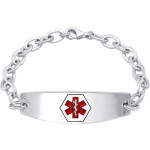 It is recommended to have a “medical” id bracelet for your child’s allergy so that it cannot be dismissed as a fashion bracelet. The allergy bracelet should be very obvious to the caregiver and be easily noticed. Here is another link to obtain a medical identification bracelet for your child. Research alternatives to obtain an medical bracelet.
It is recommended to have a “medical” id bracelet for your child’s allergy so that it cannot be dismissed as a fashion bracelet. The allergy bracelet should be very obvious to the caregiver and be easily noticed. Here is another link to obtain a medical identification bracelet for your child. Research alternatives to obtain an medical bracelet.
Go to www.Allermates.com for more products for your child with allergies including lunchboxes, cases to carry epi-pens etc.
When to Inject Epinephrine?
If your child has allergies, have you ever wondered what symptoms specifically indicate an epinephrine injection as opposed to an antihistamine? This chart clearly lists the symptoms and which course of action to take based on your observations in an allergy emergency. Click the chart to go directly to the FARE website (Food allergy research and Education)
The chart may be printed, laminated and stored within an easy reach or posted in a visible area for reference. This may also be valuable tool to give to your child’s caregiver or teacher.
ANAPHYLAXIS
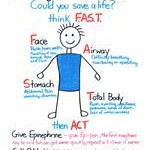 is a potentially life-threatening hypersensitivity to a substance. The reaction can occur within seconds or minutes of encountering an allergic trigger, including but not limited to an insect sting, food allergy, drug reaction (e.g., antibiotics, aspirin and non-steroidal inflammatory drugs), and exercise. Other causes include latex and, less commonly, food-dependent, exercise-induced anaphylaxis and idiopathic anaphylaxis (unknown cause). Symptoms may include shortness of breath, wheezing, difficulty breathing, difficulty talking or swallowing, hives, itching, swelling (of the face, lips, tongue, or other parts of the body), shock, or asthma. Other symptoms may include narrowing of the airways, rashes, hoarseness, nausea or vomiting, weak pulse, and dizziness. Individuals may experience anaphylaxis and not show any skin symptoms. Many individuals may have previously had only a mild reaction to an allergen, but subsequent exposure can trigger anaphylaxis. Without immediate administration of epinephrine followed by activation of emergency medical services, death can occur.
is a potentially life-threatening hypersensitivity to a substance. The reaction can occur within seconds or minutes of encountering an allergic trigger, including but not limited to an insect sting, food allergy, drug reaction (e.g., antibiotics, aspirin and non-steroidal inflammatory drugs), and exercise. Other causes include latex and, less commonly, food-dependent, exercise-induced anaphylaxis and idiopathic anaphylaxis (unknown cause). Symptoms may include shortness of breath, wheezing, difficulty breathing, difficulty talking or swallowing, hives, itching, swelling (of the face, lips, tongue, or other parts of the body), shock, or asthma. Other symptoms may include narrowing of the airways, rashes, hoarseness, nausea or vomiting, weak pulse, and dizziness. Individuals may experience anaphylaxis and not show any skin symptoms. Many individuals may have previously had only a mild reaction to an allergen, but subsequent exposure can trigger anaphylaxis. Without immediate administration of epinephrine followed by activation of emergency medical services, death can occur.
SEVERE REACTIONS IN SCHOOL
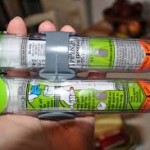 According to Food Allergy Research and Education (FARE), Anaphylaxis affects one in every 13 children (under eighteen years of age) or approximately two children in every classroom. It is estimated that 25 percent of students have their first anaphylactic reaction at school.
According to Food Allergy Research and Education (FARE), Anaphylaxis affects one in every 13 children (under eighteen years of age) or approximately two children in every classroom. It is estimated that 25 percent of students have their first anaphylactic reaction at school.
There is now legislation that allows certain school personnel to administer an Epinephrine injection when necessary while at school.
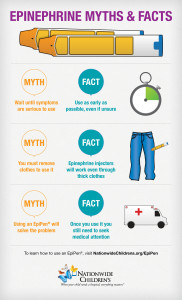 TIPS & FACTS FOR AUTO-INJECTABLE EPINEPHRINE
TIPS & FACTS FOR AUTO-INJECTABLE EPINEPHRINE
- Check expiration dates frequently on the prescription. Most expire in 1 year so will need to be filled again each school year for example. Also visibly check the medication in the tube regularly, it should be clear and not cloudy.
- Do not store the medication in your car or fridge.The best temperature for storage should be average room temperature. Inside a car can exceed triple digit temperatures which will reduce the effectiveness of the medication.
- Each time you receive a new prescription, remove the “tester” and practice. Give to all caregivers and have them practice. If your child is unable to inject themselves, make sure you practice injecting your child with the “tester”.
- The auto-injector is designed to go through clothing. It is very important to hold the injector into outer thigh for 10 seconds in order for the correct dosage to administer.
- Most prescriptions come with 2 auto-injectors. It is important to carry BOTH, not just one. It may be necessary to give the second injection, so be sure it is available.
- Even if symptoms subside after any injection of Epinephrine, you must still take the patient to the emergency room as a precaution in case other medications may be needed.
- Epinephrine is a safe drug, with the risks of anaphylaxis outweighing any risks of administering the medication. Extra caution is only needed for elderly patients or those with known heart disease where an increased heart rate could be problematic.
- For any severe symptoms: 1- give Epinephrine, 2- Call 911
Disclaimer
These are tips obtained from multiple websites and a local physician. Please confirm all of these facts with YOUR CHILD’s PHYSICIAN and be prepared in case you are in an emergency situation of your own. It is your responsibility to educate yourself and care givers for any allergy emergency. The goal of this blog was to highlight information to help caregivers become more prepared and more aware.

